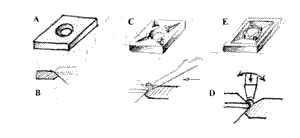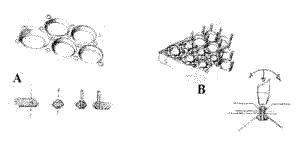|
|||||||||||||||||||||||||||
|
||||||||||||||
|
Embedding on a plate
The embedding on a plate is used for both a single stone and for more stones together according to the design of the object and to the effect that one wants to get. The plate is prepared with one or more holes (dis. A) and these holes must have such a countersink that the "culas" of the stone will lean on it in a regular way; the stones' belt will have to be slightly shorter than the plan of the surface (dis. B). At this point, who embeds, will lift with the burin some metal points (3 o 4) around the stone according to the design and to the size of the stone (dis. C). When this is done he will take the |
||||||||||||||
 |
||||||||||||||
|
remaining metal away from the so that the plan border of the surface converges towards the belt of the stone (dis. D). These inclined plans will emphasize the stone making it look larger (Dis. E). When this is done, the that is obtained will be pressed against the stone giving it a half ball shape so that it doesn't get entangled in the materials.
|
||||||||||||||
|
A "Pavè" embedding
If more stones find themselves near each other (pavè effect) the process is the same as points A and B and because the space between the stones is less than 5 they will create other in the small empty points to obtain in this way a dotting effect. The next to the stones will serve to fix them while the others will have a decorative effect (dis. A-B-C-D). |
||||||||||||||
 |
||||||||||||||
|
A point embedding
The point embedding is a variation of the one on a plate and also of the griffe one. It is used for very important "pavè" and with a great effect, especially on inflated surface. The plate is prepared with holes that will have to give hospitilaty to the stones (it's the same process used for the embedding on plate) only that instead of lifting the in that position, some little holes are made and welded in the of the threads (wires)(dis. A). Every stone according to the design-form will have from 3 to 4 to 5 points. When the work is finished there won't have to be any space between the stones, but all that |
||||||||||||||
 |
||||||||||||||
|
will have to be seen are the stones and the points of the griffes that are round like half balls, and this will give this to the object a great softness and a slight impression of quilt. This effect is obtained thanks to the closeness of the stones and to the fact that one point holds 2,3,4 stones at the same time (dis. B).
|
||||||||||||||